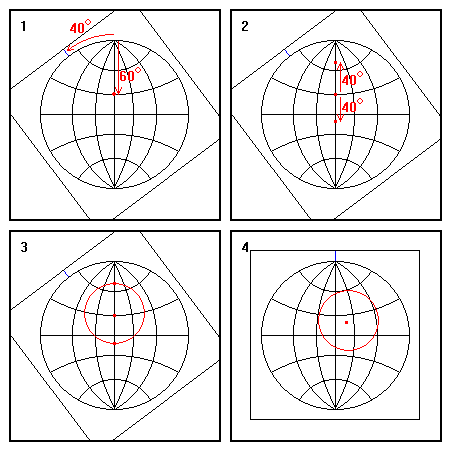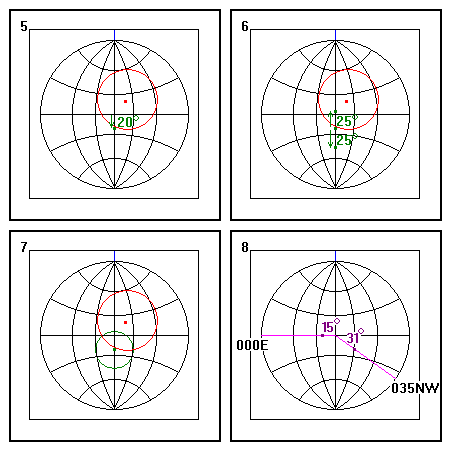Use a Stereonet to Find Find Strike and Dip From Inclined Borehole Data
Steven Dutch, Professor Emeritus, Natural and Applied Sciences, University of Wisconsin - Green Bay
When we have borehole data plotted on a map, we have enough three-dimensional data to solve for strike and dip, assuming there is a solution. There may not be if there's a change in attitude between the boreholes or a serious error in the data (and the result won't be meaningful anyway). A stereonet can save us the trouble of plotting conic sections on the map, but a stereonet only plots attitudes, not spatial data. As a result, we lose some capabilities but gain others.
The possible poles to the bedding plane will lie on a cone around the borehole and will therefore plot as small circles on the stereonet. The problem thus becomes one of plotting two small circles on the stereonet, finding their intersections, and determining the corresponding strikes and dips.
Differences Between Stereonet and Descriptive Geometry Methods
- On a stereonet, we cannot solve the case where the two boreholes are parallel. The small circles corresponding to possible bedding plane poles are identical and there is no unique solution. We've lost the three-dimensional spatial information present in map data and as a result cannot solve this case.
- We can solve the case where the bed is offset by a fault or flexure, providing the bed itself isn't rotated. There is, of course, a way of doing this by descriptive geometry as well, but it's not often applied.
Example
One borehole trends 040 degrees and plunges 60 degrees. It cuts a bedding plane at an angle of 50 degrees. A second borehole plunges south (180 degrees) and cuts the bedding plane at an angle of 65 degrees. What are the possible orientations of the bedding plane?
 |
1. Plot the trend and plunge of the first borehole (040, 60). 2. The borehole cuts the bedding plane at an angle of 50 degrees, therefore the pole to the bedding plane makes an angle of 40 degrees with the borehole. Without rotating the overlay, mark off the diameter of the small circle. 3. Draw the small circle using a compass or circle template. 4. The small circle with the overlay rotated back to true north. |
 |
5. Since the second borehole trends south (180) there's no need to rotate the overlay. Plot the trend and plunge of the second borehole. 6. This borehole cuts the bedding plane at an angle of 65 degrees, therefore the pole to the bedding plane makes an angle of 25 degrees with the borehole. Without rotating the overlay, mark off the diameter of the small circle. 7. Draw the small circle using a compass or circle template. The intersections of the two circles are the possible poles to the bedding plane. 8. Read the strike and dip corresponding to the two pole directions. This step is abbreviated here and explained more fully under Find the Strike and Dip of a Plane, Given its Pole. One solution strikes 000 and dips 15E, the other strikes 035 and dips 35NW. |
Return to Course Syllabus
Return to Techniques Manual Index
Return to Professor Dutch's Home Page
Created 15 June 2005, Last Update